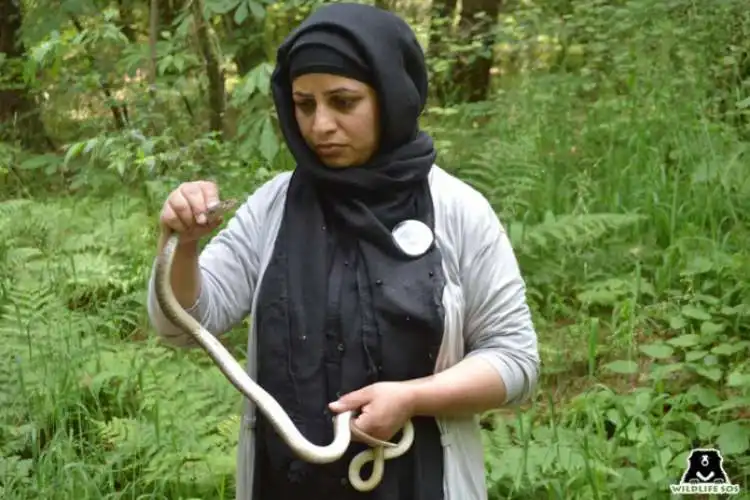
Nakul Shivani/ New Delhi
42-year-old Aaliya Mir is the face of wildlife conservation in Jammu and Kashmir. She joined the Wildlife SOS in 2002 as a volunteer and since then has been taking on diverse projects to help preserve the wildlife in her home state.
Weekend Interview
A post-graduate in Mathematics, Aaliya has a diploma in disaster management with special emphasis on animal health.
Wife of a wildlife veterinarian she was moved by the death of a bear who had ventured into human habitation in Delhi. Since then, she has made saving animals her life-long ambition.
Awazthevoice.in spoke to Aaliya about her journey and the work she has been doing in this field.
How did you get interested in working for the rescue of animals?
I have always been passionate about animals but my determination to help save Kashmir’s precious wildlife grew out of a tragic event, where I saw an Asiatic Black bear being burnt alive and dragged through the streets following the escalating human-wildlife conflict in the state. This horrifying display of brutality compelled me to take the initiative to do something to help the threatened and misunderstood wildlife in my community.
Following that incident, I was armed with a burning desire to do something and I got involved with Wildlife SOS’ cause.
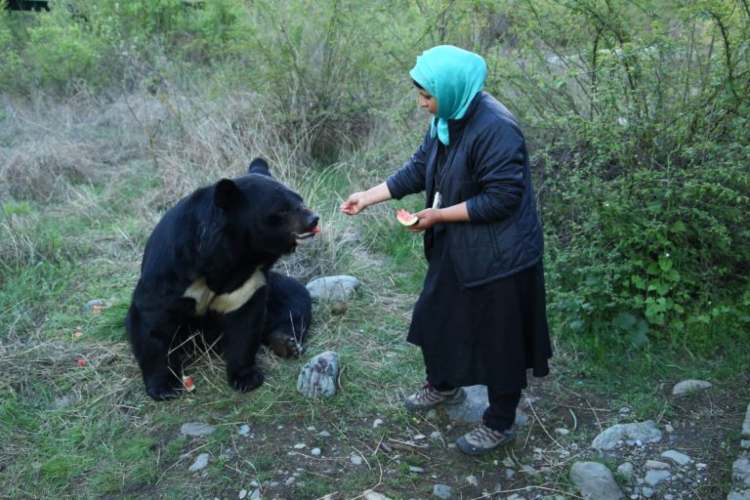 Killing of a Bear in Delhi moved Aaliya so much that she made saving wild animals her lifelong mission
Killing of a Bear in Delhi moved Aaliya so much that she made saving wild animals her lifelong mission
Tell me a little bit about your journey with Wildlife SOS... the work you do for them
In 2002, I started out as a volunteer in Delhi where I was based at the time, and in 2007, I joined them on a full-time basis here in Kashmir. I am currently heading their conservation program in Jammu & Kashmir and work as the Project Manager and Education Officer. Right from the beginning of the project, I was involved in the conduct of rescue operations to help mitigate human-wildlife conflict, especially situations involving encounters with bears and reptiles.
I am probably one of the only female rescuers within the organisation and in Jammu and Kashmir. My days are packed with the management of the two Bear Rescue centres in Dachigam and Pahalgam, attending to wildlife rescue calls, and conducting Outreach programmes.
The Wildlife SOS Bear rescue centres in Jammu and Kashmir provide a haven to 6 Asiatic black bears and 2 Himalayan Brown bears. Each of these bears was a victim of conflict situations and was rescued due to the timely intervention by the Wildlife Protection Department and Wildlife SOS.
Is there a one-stop solution for man-animal conflict or is it something that will always be work in progress?
There is no instant solution to the problem of human-wildlife conflict. Education and awareness are a long-term investment that aims to cultivate a change in the perception and attitudes of people.
However, though a slow process, this is a surefire way to create a strong link between people and nature, and foster an attitude where they feel responsible for the well-being of nature and wildlife around them.
Slowly, but surely, we are witnessing this change.
How do you educate people about the need to be sensitive towards animals?
I conduct awareness drives for affected communities, offering solutions for the people and wildlife to coexist. I often organise education and awareness programs with school and college students to encourage them to be proactive in this field. I am also involved in workshops with law enforcement agencies and the local forest department, as well as camps for local schools and visitors.
I firmly believe that education and awareness among the masses would greatly help in reducing the human-wildlife conflict and will bring a positive change in the attitude of the people. Through meetings and awareness drives in conflict areas, we can learn about people’s perception of the conflict, promote discussions on the reasons behind the increasing human-bear conflict and find solutions they should adopt to reduce the conflict.
Working towards the long-term goal of tackling the issue of conservation through education helps instill a sense of responsibility in the youth for the wildlife around them. This is a long-term investment that will not show instant results but will cultivate citizens that care about their future and the environment.
Our sessions include indoor and outdoor activities like education and awareness presentations and documentaries with schools and colleges, nature walks and camps, competitive programmes like painting or debates, and activities on special occasions like environment day and wildlife week. Nature walks and outdoor activities help students to reclaim and nurture the empathic feelings of students with wildlife and urge them to act to preserve the natural environment for wild animals.
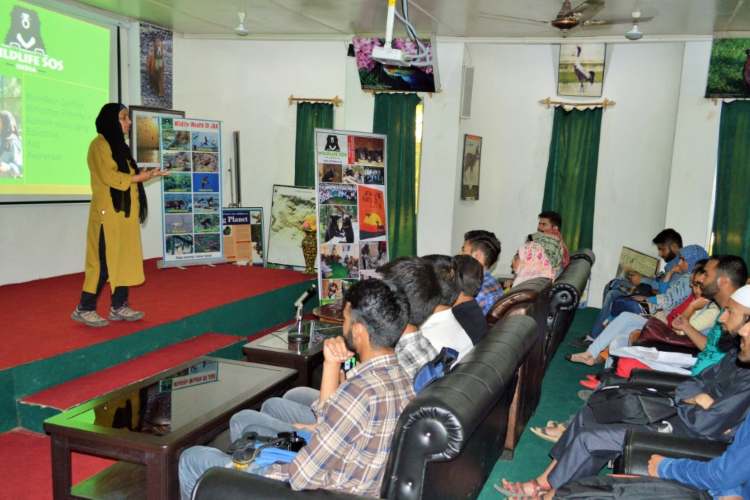 Aaliya Mir has been touring the valley educating people about the need to conserve wildlife
Aaliya Mir has been touring the valley educating people about the need to conserve wildlife
Specifically, about Kashmir... with such wonderful flora and fauna, does your work become more difficult?
Kashmir is very rich in its biodiversity, and here, you will find all sorts of animals like the Snow Leopard, Himalayan Brown Bear, Himalayan Monal, Levantine Viper, Hangul etc. However, lately, we have been seeing a lot of human-bear conflict in the valley.
In most of the places in Kashmir Valley where the human-wildlife Conflict occurs, the human settlements are adjacent to, or within the wildlife area, hence triggering conflict which could cause damage to the agricultural and horticultural crops, loss of livestock and domesticated animals, human and wildlife casualty etc.
Human-wildlife conflict attains its most serious form when people are injured or killed by wild animals. This most often results in the retaliatory killing of the animal. To ensure that these conflicts are dealt with in a proper manner, we speak to the locals and listen to their viewpoints or thoughts.
We also provide them with a platform to highlight their voices and bridge the gap between the citizens and the authorities.
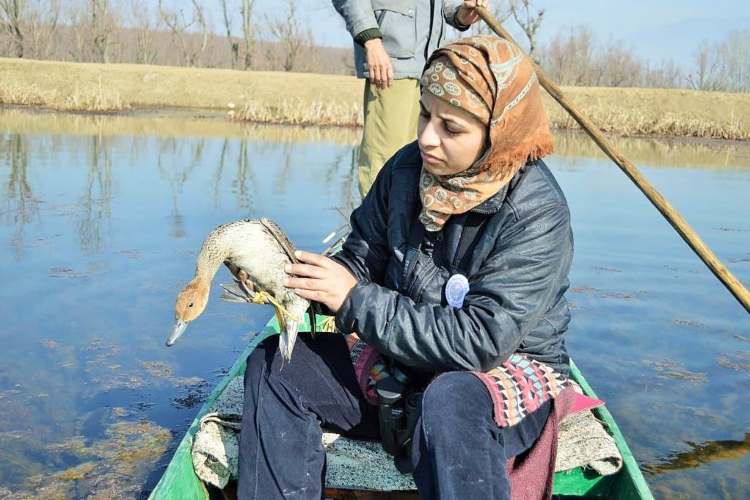 Aaliya with a bird she rescued
Aaliya with a bird she rescued
How many animals have you rescued so far?
As a part of Wildlife SOS, I have rescued over 300 reptiles and over 100 birds, including species like the Egyptian Vulture and the Golden Eagle. Additionally, I have been involved in rescuing wildlife in distress from VIP residences, housing colonies, offices of local authorities and parks
I have rescued a number of highly venomous Levantine Vipers on various occasions and safely released them into their natural habitat.
I have also worked at Zazna Village in the Ganderbal district of Jammu and Kashmir to reduce human-wildlife conflict in the area after a leopard claimed the life of a young child recently.
Along with the Wildlife Protection Department, the Wildlife team organised awareness campaigns to inform the public about the importance of human-wildlife balance in our ecosystem. We also organised programmes in the Ganderbal area to speak to young students about human-bear conflicts, who are now better equipped to deal with such situations.
Is it difficult for you to work in the field as a woman?
Working as a rescuer who also happens to be a woman, I was often dismissed or belittled by people who did not believe that I could be up to the job.
I often hear people at rescue sites whispering and asking me to stand aside as it would be difficult for me to handle the animal and most of the time, I have seen that they become flabbergasted when I end up successfully rescuing the animal.
But I had left such a line of thought a long way behind. Today, we’re slowly gaining recognition for the work we have done and people, including enforcement agencies, have begun to trust us and rely on us.
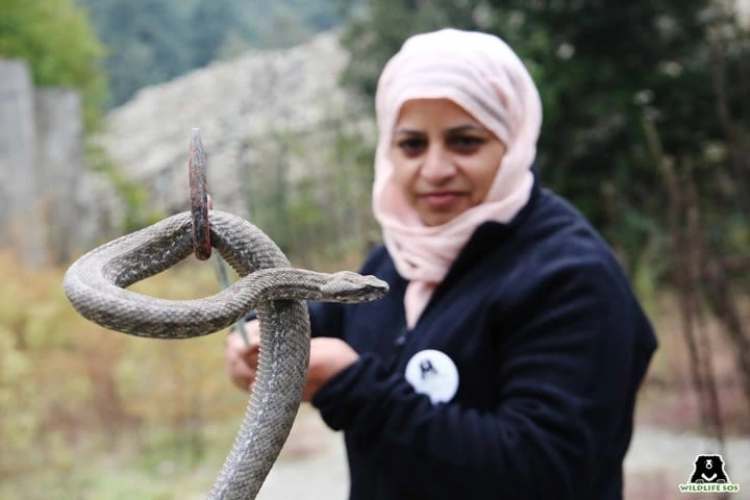 Aaliya Mir with one of the reptiles she saved from a Srinagar locality (Picture Courtesy: Wildlife SOS)
Aaliya Mir with one of the reptiles she saved from a Srinagar locality (Picture Courtesy: Wildlife SOS)
What is your dream as an animal conservationist?
As an animal conservationist, I am passionate to be a part of the conservation process and advocating for sustainable policy.
I want to educate the public on the importance of caring for wildlife and the environment and to help increase tolerance in humans towards wildlife damage, and understand and mitigate the impact of humans on wildlife and the natural environment.
ALSO READ: Ulfat Bano: Defying odds to train footballers
I wish to play a role in creating a world where we can learn to live with the animals peacefully.
